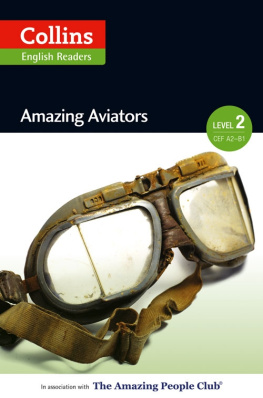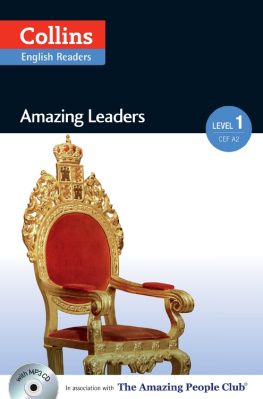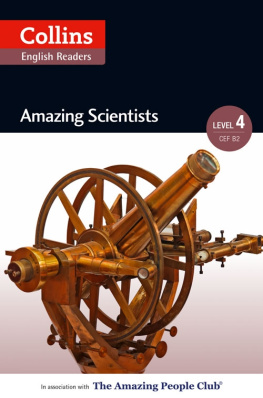Collins Amazing People Readers are collections of short stories. Each book presents the life story of five or six people whose lives and achievements have made a difference to our world today. The stories are carefully graded to ensure that you, the reader, will both enjoy and benefit from your reading experience.
You can choose to enjoy the book from start to finish or to dip in to your favourite story straight away. Each story is entirely independent.
After every story a short timeline brings together the most important events in each persons life into one short report. The timeline is a useful tool for revision purposes.
Words which are above the required reading level are underlined the first time they appear in each story. All underlined words are defined in the glossary at the back of the book. Levels 1 and 2 take their definitions from the Collins COBUILD Essential English Dictionary and levels 3 and 4 from the Collins COBUILD Advanced English Dictionary.
To support both teachers and learners, additional materials are available online at www.collinselt.com/readers.
The Amazing People Club
Collins Amazing People Readers are adaptations of original texts published by The Amazing People Club. The Amazing People Club is an educational publishing house. It was founded in 2006 by educational psychologist and management leader Dr Charles Margerison and publishes books, eBooks, audio books, iBooks and video content which bring readers face to face with many of the worlds most inspiring and influential characters from the fields of art, science, music, politics, medicine and business.
The Collins COBUILD Grading Scheme has been created using the most up-to-date language usage information available today. Each level is guided by a brand new comprehensive grammar and vocabulary framework, ensuring that the series will perfectly match readers abilities.
CEF band | Pages | Word count | Headwords |
Level 1 | elementary | A2 | | 5,0008,000 | approx. 700 |
Level 2 | pre-intermediate | A2B1 | | 8,00011,000 | approx. 900 |
Level 3 | intermediate | B1 | | 11,00015,000 | approx. 1,100 |
Level 4 | upper intermediate | B2 | | 15,00018,000 | approx. 1,700 |
For more information on the Collins COBUILD Grading Scheme, including a full list of the grammar structures found at each level, go to www.collinselt.com/readers/gradingscheme.
Also available online: Make sure that you are reading at the right level by checking your level on our website (www.collinselt.com/readers/levelcheck).

14521519
the man who painted the Mona Lisa

I had many careers during my life. I was a painter, an architect, an engineer and a scientist. But I was also a dreamer who dreamed of the future. Some of the things I dreamed about only happened many years after my death.

I was born, on 15th April 1452, in a village near the Italian town of Vinci. In those days, all the great cities of Italy were separate countries. Vinci belonged to the city of Florence.
My father, Piero Fruosino di Antonio da Vinci, was a lawyer in Florence. My mother, who was called Caterina, was a poor girl from the village. My father gave me a good education, and perhaps he wanted me to become a lawyer like him. However, my interest was in art.
When I was 14, I became an apprentice of the artist Andrea del Verrocchio. I worked with him for ten years while he taught me. He taught me the arts of painting and drawing as well as metalwork and other arts. Soon, I began to help my teacher with his paintings.
I was a good student, and by the age of 20, I was a member of a group of people called the Guild of Saint Luke. Some of the people in this group were artists, but others were doctors. The detailed drawings that artists made of parts of the human body anatomical drawings were important for doctors. So the two groups of people spent time together.
I enjoyed making these scientific drawings. But I also made religious pictures. My patrons always wanted these, and I was good at drawing and painting people. I could easily draw things that were in front of me, like many other artists. But I could also draw things that didnt exist. Having this skill made me an inventor as well as an artist. All my life, I used my imagination, as well as my eyes and hands. I used them all to invent things, as well as to make pictures.

In 1481, the monks at Scopeto commissioned me to make a picture for them. I started work on the painting, which was called The Adoration of the Magi. But I didnt finish the job. I had to leave Florence suddenly. Why was this? Id made a musical instrument from silver. It was a kind of harp which looked like a horses head. A prince called Lorenzo de Medici heard about this instrument. Lorenzo was the ruler of the city at that time. He decided to send me to Milan with the instrument. He wanted to give it to his enemy, Ludovico Sforza, the ruler of Milan. He wanted Florence to make peace with Milan and he hoped that his present could help this to happen.
I did what Lorenzo wanted me to do, and for the next 17 years I spent most of my time working in Milan. It was there in 1483, that I made the first of my two paintings of The Virgin of the Rocks. Two years later, I painted The Lady with an Ermine. These paintings later became very famous. I also designed a kind of parachute at that time.
In 1487, I made a drawing which is also very famous. I was very interested in proportions at that time. And I was interested in the work of Vitruvius. This ancient Roman architect had written a lot about the subject. He thought that there were rules about proportions in nature. And he thought that there were similar rules for the proportions between the different parts of buildings. I agreed with him. My drawing, which is now called The Vitruvian Man, shows a mans body. The arms and legs of the man are drawn in two different positions. And the man is contained by both a circle and a square. I thought that the proportions between the parts of a human body were interesting. I thought that they were like the proportions in art and architecture and in the rest of nature. I wrote my thoughts about this subject next to my drawing.

Leonardo da VincisVitruvian Man
Those years in Milan were very busy for me, and I worked on the cathedral in the city, as well as on paintings for rich patrons. I also made a ceramic model of a horse, called the Gran Cavallo. My idea was to make a very large copy of this model, using the metal called bronze. It didnt happen the bronze version was never made. Why? Unfortunately, the government of the city used the bronze to make large guns. They needed guns to defend Milan from its enemies.












